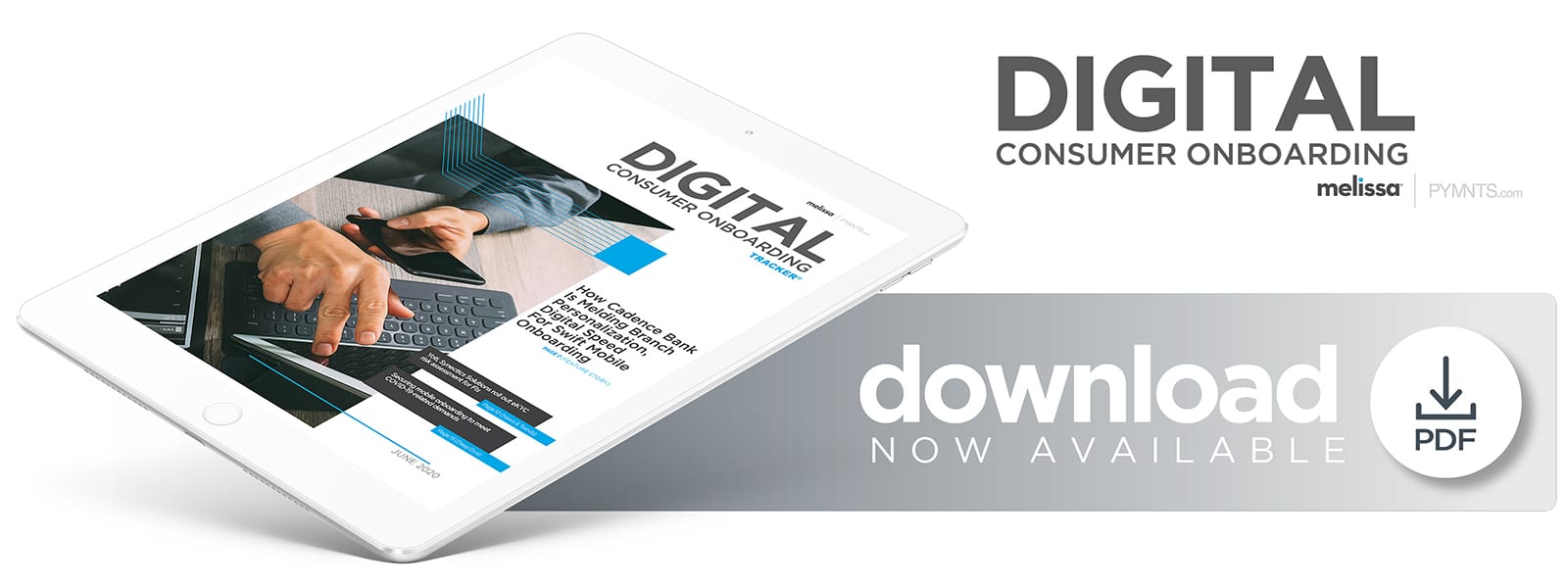How Cadence Bank Is Melding Branch Personalization, Digital Speed For Swift Mobile Onboarding

Registrations on mobile banking apps rose 200 percent in April as the COVID-19 pandemic prompted consumers to turn to remote banking services. But simply enabling consumers to open accounts via mobile devices isn’t enough, says Stephen Welling, director of retail banking for Atlanta-based Cadence Bank. To successfully onboard and engage customers, banks must enable an Amazon-like experience, as Welling discusses in PYMNTS’ latest Digital Onboarding Tracker.
Mobile banking has been edging out desktop banking for years, but branch closures during the COVID-19 pandemic appear to have given it a significant push. Registrations on mobile banking apps rose 200 percent in April, for example, and mobile traffic on such apps jumped 85 percent for the month. Even customers who typically prefer to bank or open accounts at branches are now adopting mobile banking tools as they look for ways to quickly and easily interact with their financial institutions (FIs) while brick-and-mortar locations remain closed.
This recent growth has allowed banks to more easily communicate with a larger number of customers using online tools, but FIs must be sure that their onboarding methods can keep them atop this surge, Stephen Welling, director of retail banking for Atlanta-based FI Cadence Bank, told PYMNTS in a recent interview. The onboarding experience must be easy and seamless enough for customers to complete on their own, added Thomas Sanderson, the bank’s senior vice president and digital channel manager, but banks must also make sure users are legitimate.
“Our goal is for self-enrollment, but we know we have to balance that convenience … with the challenge of making sure [customers] are who [they] say [they] are,” said Sanderson. “We try to shoot for the majority of folks [to be] able to do it themselves, but we know there are going to be times when we just need to ask some additional questions.”
The bank is relying on tools like multi-factor authentication (MFA) to balance seamlessness and security while verifying customers’ identities during mobile onboarding. It is also working to add an element of personalization in the steps that follow, including the use of call centers to verify details and online teams of consulting bankers to answer questions. Providing robust customer support across channels could prove to be a differentiator in this ongoing jump to mobile.
A Recent Mobile Push
During the COVID-19 pandemic, consumers have been using digital tools to interact with their banks at a level that appears to have surpassed FIs’ expectations. Customers typically come to internet banking for added convenience and to easily interact with their accounts — reasons that were magnified after branches shuttered amid social distancing and stay-at-home protocols.
Cadence Bank was promoting easy mobile banking enrollment through posts on its website to keep up with this trend, then saw customers “who have never thought of using the mobile app” asking how to complete it, Welling noted. Consumers’ desire to better track upcoming payments or income was a significant factor that contributed to this boost in new digital account openings, Sanderson added. This included much-anticipated funds allocated under the U.S. government’s CARES Act.
“One of the things we saw during the [arrival of] stimulus payments [was that] the enrollment rates of internet banking skyrocketed,” Sanderson said. “[This was] because people wanted to make sure they could see when they got their payments. … We could actually see those days where those [stimulus] payments were going to hit accounts. We could see the enrollment went up those days, so it is very interesting [to observe] the behavior of customers in relation to things that are happening with outside forces here.”
Customers opening mobile accounts still expect that “Amazon experience” of single-click service, Welling said — even during a rush of digital banking use and online traffic. That means FIs must make sure they can properly authenticate customers at speed and scale. Cadence Bank is utilizing MFA to do so for mobile onboarding, verifying new consumers’ names, emails, house addresses and other information on the back end and then sending text messages with codes to confirm their identities, Sanderson explained.
“If there is not a cell phone available on the record [for an SMS message], then we will walk customers through challenge questions,” he said. “That would be through a live operator [at] our call center, and then they will provide them with codes they can use on their device in order to enroll. We use the same enrollment MFA for the app and for the online desktop.”
Utilizing smartphones in the verification process helps provide the ease customers expect. The recent upswing in mobile banking account creations means it is critical for FIs to keep users invested in their digital services over those of their competitors, but onboarding must remain seamless to support this growth, regardless of consumers’ familiarity with these platforms. That requires tools for branch-dependent and online-savvy customers alike.
The Hybrid Onboarding Approach
Cadence Bank had solutions in place to steer branch customers through new account setups on their mobile phones before the pandemic, Welling said. The aim has been to create the same personalization they expect from face-to-face interactions with the convenience of mobile technologies — a hybrid approach that can expedite onboarding while retaining a necessary personal touch.
“We definitely want to walk our clients through [the onboarding process] when needed,” Welling explained. “At the same time, we feel like technology enables us to connect better with our clients and allows them to have a bank in their pocket 24/7.”
The bank has designated teams that call new customers 10 days after account creation to make sure they have access to the tools they need and that they have received items they may have requested, such as debit cards, Sanderson explained. This helps bring the feel of in-branch banking to the digital sphere. Cadence Bank is also expanding its use of such tools during the pandemic to retain that feeling during onboarding and afterward. It has launched a mobile option that customers can use to schedule appointments with bankers, as well as a program that facilitates the same “walk-through” account creation process the FI typically provides in branches.
“We have started a pilot project we call digital client advisors,” Welling said. “The vision on this is, let us say [customers] have the desire to open up either new relationships or an ancillary account. They go [to our online channels] and request appointments [that can be] handled end-to-end over a digital environment [by our bankers through] Zoom, email or text.”
The bank expects program adoption to grow, too. Remote representatives will support digital requests from customers in certain geolocations, rather than working in specific branches like more traditional financial advisors. This will allow them to serve a greater number of customers, as they will not be limited to those near brick-and-mortar branches. The company aims to make these online conversations as similar as possible to those that would take place in person.
Online banking app usage is expected to continue in the pandemic’s aftermath, which means bringing this aspect of in-branch banking to mobile could help FIs differentiate themselves. Providing an experience through smartphone screens that feels tailored to each customer helps to generate immediate trust among those looking to create new banking relationships — and just might vault FIs over their competitors when consumers consider where they should create their next accounts.

